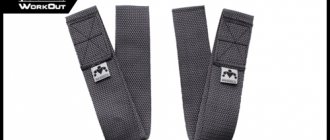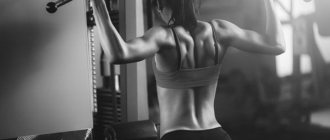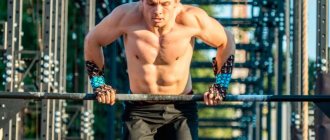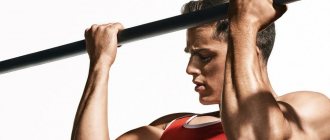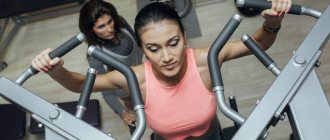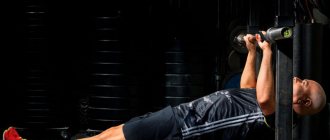Save for yourself so as not to lose:
- Working principle of a rubber band
- How to choose a latex loop?
- How to properly use latex tape when doing pull-ups?
Those learning to do pull-ups (either from scratch or to increase the number of repetitions) are often advised to use latex bands. This type of expanders is also called elastic bands or rubber loops. Elastic bands made of durable latex material are suitable for both indoor and outdoor activities. In addition to pull-ups on the horizontal bar, you can use this expander to perform many other exercises for different muscle groups. A set of latex rubber bands will replace a whole range of sports equipment and equipment. In this article, we invite you to discuss how to choose the right elastic band for pull-ups on the horizontal bar. Let's look at what criteria you need to pay attention to when buying an expander, and also touch on the issue of its proper use.
About the benefits of pull-ups
Mastering an exercise aimed at lifting your own weight to the bar allows athletes to significantly strengthen their arms, inactive back muscles, shoulder girdle and abdominal area.
By regularly performing pull-ups, athletes increase their own endurance. If the student’s goal is progressive loss of excess fat mass, exercises of this plan will also come in handy.
However, you should not rely only on pull-ups, since strengthening only the upper half of the body can cause muscle imbalance, and this is fraught with serious negative consequences for the body.
Reason #1: Weak forearms
The essence of the action of hooks is to remove part of the load from the forearms. Due to this, an athlete who does not have a strong grip can level out his deficiency and train fully.
Watch which muscle goes into failure first during pull-ups, deadlifts, and other similar exercises. In pull-ups, the most problematic area is the biceps. Forearms follow. When it comes to deadlifting, it's almost always your grip strength that lets you down. But both movements are aimed at developing the back muscles! When the forearms have already “turned off”, and therefore the athlete is forced to complete the approach, the back muscles still have 3-4 repetitions left to reach 100% development. Bottom line - after back day, your forearms and biceps hurt, not your back. The lats do not receive enough load, as a result of which the back muscles begin to lag behind, and the overall impression of the figure deteriorates. A broad back and shoulders are the calling card of every athletic man, so it is extremely important to train your lats to their full potential.
Pull-up bar hooks come to the rescue, taking the load off your forearms and biceps, which allows you to train your back to its full potential.
Weighted pull-ups
With frequent activity on the horizontal bar, the body gets used to the stress. And in order to further achieve results, you can take various weighting materials. However, not everyone can use them.
Safety precautions:
- Weights put a lot of stress on the spine, so you need to perform all exercises correctly.
- Any sudden movements should be avoided. All actions must be smooth.
- When doing pull-ups with weights, do not jump.
The following are used as weighting agents:
- vest;
- weights for legs;
- weight;
- backpack with various contents.
All exercises are performed as with regular pull-ups, several approaches with breaks. Each time you can change the way you grip the bar and the distance between your hands so that the muscles work more intensely.
Advantages of the simulator
Any modern elastic band for pulling up is made from 100% latex, which allows the product to maintain a stable level of resistance even with regular heavy loads. For this reason, elastic bands have a virtually unlimited service life.
The ends of the elastic bands, made in the form of a closed loop, facilitate quick and reliable fastening of the device to any horizontal or vertical crossbar.
Elastic bands for pulling up and doing fitness are indispensable for people who have to spend a lot of time traveling and on business trips. The ability to use such a product at home becomes indispensable for users who do not want to exercise in the gym or on an open sports field.
In general, the elastic band for pulling up has the following advantages:
- Highest resistance to mechanical loads, increased tensile strength.
- The ability for an athlete to change the biomechanics of habitual movements, lightening or increasing the load, using a tape with a targeted focus on training specific muscle groups.
- Affordable price for the bulk of interested consumers.
- A wide variety of models of different lengths, resistance and appearance.
Characteristics of rubber bands by color
Manufacturers mark their products in different shades, which makes it easier to select and use a tape expander. The coloring reflects the degree of external resistance of the compact sports device.
The standard color gradation of such products is shown in the table:
| Expander shade | Weight compensation level for exercises (kg) |
| Orange | 2-15 |
| Red | 5-22 |
| Violet | 12-36 |
| Green | 17-54 |
| Blue | 23-68 |
| Black | 32-77 |
This is an approximate color gradation, which does not always correspond to reality. Some manufacturers use their own color marking scheme. The level of external resistance created by the product is always indicated on the packaging. On sale there are models of tape expanders in non-standard shades - yellow, light green and others.
The marking contains clear instructions on the load level provided by each product. 2 numerical values are given in kg. The first number displays the degree of external resistance when the product is stretched by 50%, and the next, separated by a hyphen, is the maximum value.
How to Achieve Muscle Failure in Pull-Ups
One of the main problems of training aimed at increasing strength is the athlete’s inability to perform the final movements until the muscle mass fails. Typically, athletes experience minimal gains in their body's performance due to their inability to push through the finish line through pain.
In such a situation, an elastic band for training is simply an indispensable aid. To achieve results in the training process, it is enough to perform pull-ups without equipment. And only at the final stage, if you feel unable to overcome the initial loads, should you resort to using an elastic band.
The use of a tape makes it possible to additionally perform about 3-5 pull-ups, and when using the most rigid device - up to 10 repetitions. Thus, achieving muscle failure will provide the necessary stimulation to the muscles, which will give impetus to its subsequent growth. Sports enthusiasts, like professional athletes, often resort to this method using an elastic band.
Reason #4: You don't want to pump up your forearms.
Simple conformism or reluctance to fight a lagging muscle - horizontal bar hooks will help you with any similar problem. But if you don’t consciously want to improve your grip in basic exercises, be prepared for the fact that when working with really heavy weights, your forearms will still begin to limit your progress. Most amateurs do not set themselves the goal of deadlifting 200 kg, or pulling 150-170 kg based on their own body weight. If you want to get to these levels, but still intend to use hooks in every compound exercise, read more about how to develop grip strength without giving up using hooks.
How to choose an elastic band for a horizontal bar
Before you start exercising on the horizontal bar using an elastic band, you need to choose exactly the one that is ideal for your weight and the specifics of your exercise system. Before choosing the equipment you need and need, decide how you will conduct your training.
The fact is that depending on your current weight and muscle condition, you may need different elastic bands. They differ in their appearance and functionality for a reason - some of them allow you to perform heavy exercises and can compensate for weight up to 80 kilograms.
It is clear that with such an elastic band it will be difficult to achieve a noticeable result, because it will practically do everything for you. It’s a completely different matter when the weight compensated by the elastic band is only a couple of tens of kilograms. In this case, it will just be a good help in doing the exercise.
But bands with a minimum weight rating are not always suitable for beginners because they do not provide enough support. Therefore, for those who want to acquire this equipment, I recommend
Which elastic band should you choose for pulling up on the horizontal bar?
Taking these 4 nuances into account, we created our own table for selecting a rubber loop for pull-ups . There are only 2 elastic bands: purple 11-36 and red 17-54 kg , as well as their combinations. Of course, these are only general recommendations, but my 5 years of experience in selecting elastic bands for clients says that this technique is relevant for most men and boys.
Ladies, it’s more difficult with you, a lot depends on your physical shape and it’s difficult to give a specific recommendation. For beginners, it is better to choose a loop of 15-48 kg or 17-54 kg, no less. Although for some this help will not be enough, and you will need to use a 5-22 or 11-36 kg loop in addition.
Friends, for those who doubt and choose between 2 loops, the following advice. Our experience shows that people usually overestimate their strength, so it is worth choosing a tighter loop. Of 2 evils, choose the lesser, of 2 assholes - the big one, of 2 loops - the thick one)
You will feel its benefits during your first lessons:
- It will help cope with an unusually heavy load.
- You will be able to increase the number of repetitions of each exercise.
- It will help you master a narrow grip, which swings the pectoral muscles well and gives an effect no worse than a barbell. The difference is that on the horizontal bar, when performing this exercise, many more muscle groups work.
For a beginner, using an eraser will make it much easier to perform an exercise called “typewriter.” Movement in a horizontal plane on bent arms, thanks to which all the muscles of the shoulder girdle are strengthened. This exercise is especially difficult to perform at the very beginning of training.
Reason #3: Learning proper technique
The same exercise with the same technique can load different muscle groups. The brain-muscle connection is responsible for this, the correctness of which every fan of “iron sports” should work on. Horizontal bar hooks are used when the athlete has already made a mistake and has not been able to develop the correct neuromuscular connection. In this case, use gloves for the horizontal bar with hooks, or regular hooks for the horizontal bar, to correct the brain-muscle connection and teach the athlete to turn off the forearms and biceps from the work. This is true for athletes whose biceps and forearms “clog” before their lats.
Lightweight pull-ups
Today, I will offer you 4 options to simplify pull-ups, I will show you the leading movements, having learned to perform which, you will definitely learn how to do pull-ups yourself. Moreover, what I will show is suitable for both girls, women and men.
I really hope that the female audience is also interested in pull-ups, and I will be useful to them. The exercise is extremely beneficial for the back muscles and the whole body as a whole. Let's start looking at options for simplifying the exercise, that is, lightweight pull-ups. Make yourself comfortable, I'm starting! Just let's agree, try to work it all out in practice.
Pull-ups from your feet
The first option to do lightweight pull-ups on the horizontal bar is to perform pull-ups from your feet. To do this, you will have to lower the bar to the level of your thoracic region. Or find low beams or put something under your feet that will become yours. In general, use an experimental method to select the desired height of the horizontal bar.
We grab the bar with a reverse grip and lower ourselves to the very bottom. It turns out to be a deep squat with your arms extended upward and with which you hold onto the bar. Now, the task is to try to do a pull-up, helping yourself with your legs to rise up
Attention, in the upper position, rise on your toes to increase the range of motion and get the maximum benefit out of the exercise. Place your legs wide apart and try to relax them as much as possible. Take your time to get up, do the exercise at an average pace
In the upper position, you can take a short pause and lower down, also under control, with a feeling of muscle tension in the working muscles.
Jumping pull-ups
The second option to perform lightweight pull-ups is to do so-called jumping pull-ups. When you have the opportunity to push off the floor with one or two legs, give yourself an initial impulse (acceleration) and perform the remaining two-thirds of the exercise yourself, due to muscle work. Again, take your time and control your movement both up and down. It's better to do less, but better.
Pull-ups with rubber loop
The third option for a lead-in exercise to performing full pull-ups is to perform pull-ups with a rubber loop. In the stretched position, the rubber loop tends to contract, pushing my body upward.
Rubber loops have different resistances, so, regardless of your body weight and level of physical strength, each of you can choose a loop that will suit you.
Negative pull-ups
The fourth option for performing lightweight pull-ups is to learn the negative pull-up exercise. When your muscles work in a yielding mode, and from a contracted state they strive to lengthen. The yielding mode of muscle work is very good, and requires a lot of concentration and muscle tension from a person, with all the ensuing positive bonuses for the whole body.
You get into a pull-up position where you're at the very top, with your arms close to your body. And for about 3 - 4 seconds you begin to slowly go down, controlling the movement. The task is to lower yourself, fully straightening your arms at the elbow joints. They lowered themselves, rose again to the final position of the pull-ups, and began to lower again. Controlled downward movement is the main thing in this exercise.
It would not be entirely correct to say that this is a lightweight version of pull-ups. The exercise is quite complex, but still much more accessible to most people. And you can use it to increase your strength, to train the muscles of the shoulder girdle, back, and arms. Use this exercise as a lead-in to your first real pull-ups!
Video lesson on performing light pull-ups from Alexey Dinulov
Exercise technique
Pull-ups with an elastic band in terms of technical execution and method of developing a training program do not differ from similar workouts without the use of an auxiliary simulator. This type of exercise is considered difficult even for a physically developed person. Before doing pull-ups on the horizontal bar, first of all, warm up the muscles and joints to avoid damage and injury. With rubber loops, you can perform pull-ups with either a wide or narrow grip.
Holding the bar with a certain grip, the tape should be placed in front of the body. Place your feet or knees in the loop so that you can stretch it. Your arms should be completely straight. As you exhale, you need to tense the muscles of your back and arms, while trying to pull your chin towards the bar. You need to perform muscle contractions as during regular workouts without a band; at the same time, the resistance of the band itself will push the body upward. As you exhale, slowly straighten your elbows. If training is intended to develop muscle strength, then it is best to do repeated exercises as many times as possible. After several sessions, the body will slowly begin to adapt, and pulling up with your own weight will be much easier. To take your fitness to the next level, you'll need a different band.
Pull-up bands do not significantly reduce the time needed to achieve quick workout results. But with their help, even beginning athletes achieve visible results after just 2 months of systematic training.
Train correctly
If you want to get a beautiful body, you need to engage in effective exercises. To achieve the expected result, first of all, you need to learn how to learn how to do pull-ups in such a way as to develop the muscle group that interests you. Since different grips give different results, although this is not visible at first, you need to approach your choice wisely.
First, you should decide what exactly you expect from training. Do you want to build muscles? Or are you counting calories in an effort to lose weight? If you have never done anything like this before and have no idea what it is, then your best option would be to consult with a specialist in this field. Depending on who you contact, the trainer will recommend a specific course of study. This will be the program that will give you the opportunity to make yourself better.
And each of the trainers, in any case, will advise you on a certain technique, tested in practice, which will include a horizontal bar and exercises associated with it. And the more of these exercises you need to do, the more likely it is that you will need an elastic band.
Where to buy an elastic band for pull-ups at a good price
I can recommend a couple of places where I usually buy it myself. This is Aliexpress (I talked about it at the very beginning of the article about harnesses), and the Decathlon online store. There is always something to choose from, despite the fact that the price tag is lower than in SportMaster.
I think you understand that depending on your needs, you can choose any type of elastic bands you need. Play sports, develop and become more resilient and stronger. I hope you found this article helpful! If you have not yet subscribed to the adventure blog “On the Edge,” you can do so right now and be the first to know about the latest news and current events. See you!
Text - Agent Q.
Essence and basic principles
Pulling is a basic physical movement. This means that large muscle groups are involved in the process of its implementation. Depending on the type of grip selected on the horizontal bar, the main emphasis of the load can change as follows.
| Grip type | Muscles under load |
| Straight slightly wider than shoulder width. | A direct grip is understood as a position of the hands in which the palm is turned away from the person doing the exercise. In this case, the main load falls on the latissimus and teres dorsi muscles, and the biceps brachii muscle is practically not included in the work. The trapezius and posterior deltoid muscles are also involved. |
| Straight wide grip. | Loads the latissimus dorsi muscles in maximum isolation. The biceps and other flexors of the arm in the elbow joint are completely disabled. A lot of force occurs in the shoulder girdle area. Not recommended for beginner athletes. |
| Narrow straight. | Placing your hands on the bar allows you to shift the emphasis of the load in the exercise to the inner and upper back (trapezius and deltoid muscles). Due to the deflection of the body when lifting, the muscles of the upper chest are worked out. |
| Reverse grip. | Placing your hands on the bar with your palm turned out towards the student. This type of grip is conventionally considered a power grip. The biceps brachii muscle and the arm flexors at the elbow joint are intensively involved in the work. A reverse grip can be performed with a narrow or medium position of the hands on the horizontal bar. The muscles involved are similar to those that are stressed when holding the arms straight. |
When performing variations of pull-ups, it is important to follow the correct technique.
Rules and recommendations
There are several key recommendations that must be followed when performing pull-ups on the horizontal bar:
- Movement is carried out strictly by muscle contraction. Involvement of inertial forces (swaying and jerking while hanging) is not allowed.
- Raising and lowering must be controlled. Jerking during the positive phase of movement (contraction of muscle fibers) and falling during the negative phase (relaxation of the body) are prohibited.
- It is necessary to follow the correct sequence in breathing. Inhalation is carried out when lowering, exhaling - when rising.
- The hands must be firmly fixed on the horizontal bar. This allows you to create an additional static load on the finger extensors and achieve the necessary level of safety when performing the exercise.
Each type of pull-up has its own characteristics that must be taken into account when performing the movement. With a narrow straight grip, you should strive to touch the bar with your lower chest at the top point of the amplitude. This will allow the maximum number of muscle fibers to be involved in the work.
When doing pull-ups with a wide arm position, there is no need to reach up so high. The peculiarities of the structure and attachment of muscles in the human body are such that such a trajectory of movement is unnatural and can lead to injury.
Complexes of exercises on the horizontal bar for inexperienced athletes should not consist of a large number of exercises. Novice male and female athletes are not able to perform a large amount of work. Excessive loads can cause aversion to sports.
An elastic band for pulling up on a horizontal bar is the optimal solution in this situation. Properly selected load is the key to sports longevity. And obtaining a result and consolidating it is the result not of one-time records, but of a long process of regular work.
The best manufacturers, prices of expanders
The range of elastic bands is varied; the highest quality products are produced by the following companies:
- Esonstyle;
- Indigo;
- Brandismo;
- Protrain;
- Plaster;
- Brandex.
Elastic bands are sold both individually and in sets. The last option is preferable. Several expanders of different hardness expand training possibilities and are cheaper than individual ones. For a set of elastic bands for pulling up on a horizontal bar in a sporting goods store you will have to pay about 3500-4000 rubles.
Elastic band for pulling up: how to choose
Elastic bands are selected according to the color that matches the resistance level of the device. For example, the least rigid orange bands have a resistance of up to 10 kg. This option is suitable for athletes whose weight is no more than 75 kg. Blue and green elastic bands are intended for athletes weighing 90-95 kg. The toughest black bands have a resistance of about 70 kg and are recommended for athletes weighing over 110 kg.
People who are able to do no more than 3 pull-ups during a set and want to master a technical element should use several elastic bands of different levels. In this case, a device with increased rigidity will allow you to work in warm-up mode, performing from 10 to 20 lighter repetitions. A more elastic product will open up the opportunity for strength training, which will have a positive effect on strengthening muscles.
Consolidate the result
To consolidate the results, after each workout it is necessary to stretch all the muscles involved in the exercise.
- Back. To relax the latissimus muscles, you need to rest your hands on the vertical support of the horizontal bar. In this case, the hands should be slightly below shoulder level. After this, take 1 shallow step back so that the body is tilted forward. After this, light body turns should be performed.
- Shoulders. The arm bent at the elbow should be raised to a horizontal level. In this position, the hand of the limb of the same name must be moved behind the opposite shoulder. That is, if the right arm is raised, then the hand should be moved beyond the plane of the left shoulder.
- Anterior thigh. The leg bent at the knee is pulled back.
- Pectoral muscles. The outstretched arm at shoulder level rests on the horizontal bar post and is fixed on it. After this, it is necessary to slightly rotate the body in the opposite direction.
Rules for training
The final result depends on the correct technique of performing the exercises.
Training rules:
- Before starting your workout, you should do a warm-up to warm up your muscles.
- In the starting position, the body should hang straight. You can bend your back a little. Legs must be bent at the knees and crossed.
- When doing pull-ups, you need to breathe correctly: inhale on the way up, exhale on the way down.
- When performing exercises, you do not need to throw your head back. This can harm the cervical vertebrae.
- The crossbar must be held firmly.
- You need to pull yourself up not with your arms and swaying your body, but with your back muscles.
- During the pull-up process, the chin should be above the bar.
- The slower the exercise is performed, the more efficiently the muscles work.
- Pull yourself up and lower yourself to the original position smoothly.
Your hands will get used to the load and then you can move on to pull-ups. To improve the process, you can use various means (weights, elastic).
Pros and cons of using an expander
A sports accessory can increase loads by limiting movements, which accelerates muscle development. An important advantage of modern expanders is the stability of resistance during long-term and regular training.
The obvious advantages of pull-ups with an elastic band include:
- unlimited service life of products made from high-quality latex;
- the ability to securely fasten the accessory to a vertical rod or horizontal crossbar using closed loops at the ends;
- versatility - such a device is used with equal effectiveness by both men and girls;
- Possibility of use for independent home exercises or outdoor training;
- light weight and compactness;
- applicability for the formation of skeletal structures in adolescents;
- increased resistance to tensile loads and mechanical tension;
- affordable cost, which allows you to have several expanders with different resistance in your arsenal;
- targeted and targeted pumping of muscle groups;
- a wide variety of designs and models.
The disadvantages of elastic bands include the difficulty of using them with an insufficient level of physical fitness and significant body weight. Failure to comply with the exercise technique creates excess stress on the muscle fibers, which are subject to unnecessary stimulation.
This leads to a rapid increase in strength indicators and relief, which is undesirable for girls working out for the purpose of correcting their figure and maintaining an aesthetic appearance. Among the disadvantages of pull-ups with an expander, one can highlight the presence of contraindications.
These include:
- arthrosis;
- scoliosis deformity of the spine;
- osteochondrosis;
- protrusion.
You cannot do pull-ups with an elastic band if you have a herniated disc or other destructive diseases of the skeletal muscles and skeletal system.


